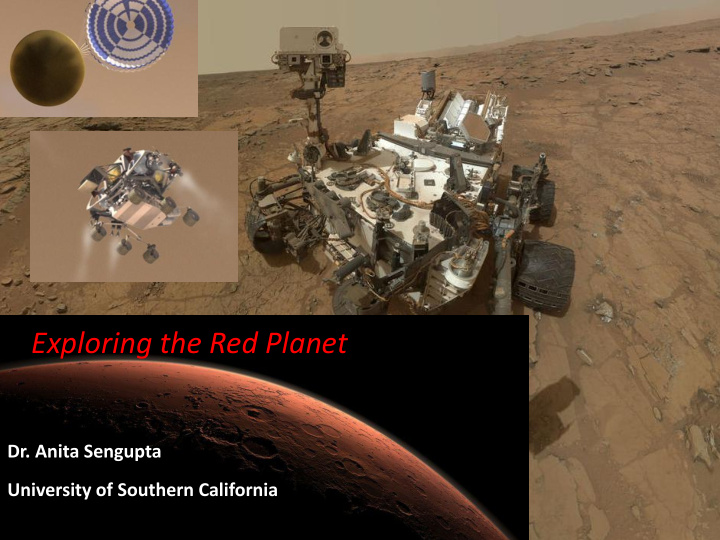



Exploring the Red Planet Dr. Anita Sengupta University of Southern California
How do we land on Mars?
Why Are We so Interested In Mars? Earth and Mars Look very Different From Each Other, but what about at the beginning of time? 3
Could We One Day Live on Mars 24.6 hrs • How long is the day? • 1/3 Earth What is the gravity -90C to 5C • What is the Temperature Range? 1/100 • Surface pressure compared to Earth • What is the Atmosphere made of? CO 2 4
Active Geological History • Olympus Mons – Largest Mountain in the Solar System: 21,000 m high – 3 times as high at Mount Everest • Valles Marineres – Largest Valley in the Solar System – 4,000 km long, 200 km wide and up to 7 km deep – 6 times as deep as Grand Canyon Olympus Mons Valles Marineres 5
Moons of Mars Does Mars Have Moons? Phobos and Deimos 6
Waters of Mars • Large bodies of water once flowed on the surface • Polar Caps have water ice • Phoenix Lander Found Brine Water Have We Found Water on Mars? 7
Is there Water Flowing on Mars Today? • NASA confirmed just last week that Mars has water flowing on the surface • Mars is tilted on its axis resulting in seasonal freezing and thawing of subsurface water Have We Found Flowing Water on Mars? 8
Landing on Mars • How many times have we landed on mars? 7 times! – Viking Landers (2) – Pathfinder Sojourner – Spirit and Opportunity (2) – Phoenix Lander – Curiosity: Aug 2012 – Next: Insight (2016) 9
Learning from Past and Building the Future
Mars Science Laboratory • Was Mars a habitat for life? • Largest Rover Mission to date • Advanced suite of instruments for organic molecule detection • Advanced EDL
Picking a Landing Site: Gale Crater 12
Did Mars Once Support Life? The Mars Science Laboratory • Biological Potential • Geology and Geochemistry • Role of Water • Surface Radiation
Gale Crater Gale Crater Targets a 20 km Landing Ellipse Mt. Sharp in the middle of Gale Crater is as tall base-to-peak as Mt. McKinley in Alaska, which is the tallest mountain in North America 150-km Gale Crater contains a 6-km high mound of stratified rock. Strata in the lower section of the mound vary in mineralogy and texture, suggesting that they may have recorded environmental changes over time. Curiosity will investigate this record for clues about habitability, and the ability of Mars to preserve evidence about habitability or life.
Bulls Eye on Mas 15
Faster than a bullet 50 times as fast as an airplane
Curiosity is the Size of a Small Car
The Rover Needs Eyes Too ChemCam RMI Right Navcams Left Navcams (2) (2) Left Mastcam Right Mastcam (34 mm) (100mm) MAHLI Right and Left Rear Hazcams (2 pair) Right and Left Front Hazcams (2 pair) MARDI
Science on Mars!
SAM & CheMin SAM instrument which takes up more than CheMin half the science payload on the rover CheMin uses X-rays to determine mineral content and crystal structure of surface samples Sample Analysis at Mars (SAM) is the rover’s Easy Bake Oven.
Reach out and touch someone • Drill • Scoop • Microscope • Brush • APXS Instrument
How long does it take to get to Mars? 7 - 9 months
Landing Night: The Birds Eye View
Curiosity landed in an ancient lake on Mars
Post Landing EDL Assessment
and so the Journey Began
Behold the Ancient Martian Riverbed
Fine layers that indicate sediment transport Phylosilicates formed in the presence of water Neutral soil alkalinity
Scooping the Soil
Lasers on Mars 30
A Laser (ChemCam)
Mars Weather
Mars Radiation
Methane on Mars
1 year on Mars (in Two Minutes) Would you want to go to Mars? http://www.youtube.com/watch?v=CP3cud3QIaM&sns=tw
Intelligence on Mars
Would You Want to Live on Mars? #journeytomars 37
Who Knows What Is Over The Next Horizon @Doctor_Astro • Over a 1000 of engineers and scientists made this a reality • 12 countries contributed scientific instruments or have participating scientists on the project • All the images returned to Earth are publically available minutes after they arrive because this is our rover http://mars.jpl.nasa.gov/msl/ 38
Recommend
More recommend